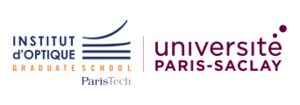Institut d'optique Graduate School facts for kids
 |
|
|
Other name
|
SupOptique |
|---|---|
| Type | Grande école |
| Established | 1917 |
|
Parent institution
|
Paris-Saclay University |
| President | Elisabeth Giacobino |
| Director | Rémi Carminati |
|
Academic staff
|
50 |
|
Administrative staff
|
200 |
| Students | 600 (400 in MScEng, 50 in MSc, 150 in PhD) |
| Postgraduates | 450 |
| 150 | |
| Address |
2 avenue Augustin Fresnel, Palaiseau
,
Paris-Saclay (Palaiseau & Orsay), Saint-Etienne, Bordeaux
,
France
|
| Campus | Campus Paris-Saclay |
| Affiliations | ParisTech |
The Institut d'optique Graduate School, often called SupOptique or IOGS, is a special school in France. It is part of Paris-Saclay University and ParisTech. This school teaches students all about optics, which is the science of light.
Contents
History of Light Science School
How SupOptique Started
The idea for the Institut d'Optique came from Armand de Gramont. He was a rich businessman and a friend of the famous writer Marcel Proust. In 1916, Gramont worked with Henri Chrétien, a French astronomer. Chrétien was calculating how optical instruments should be built.
They both decided to create a school just for teaching optics. That same year, Gramont joined a group that looked at new inventions for the French military. There, he met Charles Fabry. Fabry was famous for showing that the ozone layer exists in our atmosphere.
On October 21, 1916, Gramont met with four government ministers. This meeting led to a new group being formed. This group was in charge of planning the new optics institute. The first official meeting for the school happened in November 1917.
Opening the School of Optics
The École supérieure d'optique (ESO) opened in 1920. It was part of the Institut d'optique théorique et appliquée. The goal was to train engineers and leaders for France's optics industry. This makes it the oldest school in the world for higher education and research in optics. It also trains the most graduates each year.
The Institut d'optique Graduate School gives students a very high level of science education. Many students come from special French preparatory classes. The school trains engineers to work in industry and research. They help develop optics in many areas. These areas include phone networks, biology, energy, new materials, tiny technologies (nanotechnologies), and space engineering.
The school also trains researchers and teachers in optics and physics. Through its work, it helps share knowledge and create new techniques in optics around the world. Since September 2006, the school has been known as the Institut d'optique Graduate School or Institut d'optique.
Academics and Learning at SupOptique
Famous Scientists and Teachers
Many well-known French scientists who study optics have been connected to SupOptique. These include Henri Chrétien, Charles Fabry, André Maréchal, and Alain Aspect.
In 2006, the school had 50 full-time teachers and researchers. It also had 241 students in its engineering program. There were 15 students in a national research master's program. Plus, 40 students were working on their doctoral degrees (PhD).
Research and Discoveries
Exploring Light and Atoms

Most research groups at SupOptique are part of the Charles Fabry Laboratory. This lab has been around since 1998. It works with the CNRS and Université Paris-Sud. Patrick Georges is the director of the laboratory. In 2022, the lab had 64 full-time staff and 67 PhD students.
In 2022, the lab had several research groups:
- Quantum Gases: This group studies super-cold atoms. They look at how these atoms behave. They also created the first super-cold helium gas in 2001.
- Quantum Optics: This group explores the basic rules of quantum mechanics. They work on secure communication using light. They also create and control special light states.
- Imaging and Information: This group works on digital image processing. They also design better camera systems.
- Nanophotonics & Electromagnetism: This group studies how light behaves on a very tiny scale. They work with tiny optical devices and new materials.
- Laser Group: This group creates new types of lasers. They work on very short light pulses and powerful laser systems.
- Biophotonics Group: This group uses light to study living things. They look at how light can help with medical imaging. They also study tiny parts of living cells.
- XUV Optics Group: This group designs and makes special mirrors. These mirrors are used for telescopes and other tools. They made mirrors for the STEREO mission for NASA. They also made mirrors for the Solar Orbiter's EUI instrument.
- Non-linear Photonics Group: This group studies how light behaves in unusual ways. They look at how light changes when it passes through certain materials.
See also
 In Spanish: Escuela de Graduados del Instituto de Óptica para niños
In Spanish: Escuela de Graduados del Instituto de Óptica para niños



